Changes to the liturgy are taking effect this weekend. The new English translation is designed to be more consistent with the original Latin.
Where are American Catholics on the issue of change in general? It’s a mixed weather pattern.
In Pew’s 2007 Religious Landscape Survey there is a question that asks, “Thinking about your religion, which of the following statements comes closest to your view? My church or denomination should preserve its traditional beliefs and practices; or adjust traditional beliefs and practices in light of new circumstances; or adopt modern beliefs and practices.”
A majority of U.S. Catholics surveyed responded that the Church should either “adjust traditional beliefs and practices in light of new circumstances” (44%) or “adopt modern beliefs and practices” (14%). More than a third (35%) indicated that the Church should “preserve its traditional beliefs and practices.” The remainder volunteered another response, didn’t know, or refused to answer. The map below displays the “preserve its traditional beliefs and practices” responses by state.
Respondents in states shaded in blue or purple have the highest percentages of Catholics responding that the Church should “preserve its traditional beliefs and practices.” Catholic respondents in states shaded in yellow and orange are least likely to respond as such (i.e., more likely to prefer change).
The traditionalists are in greatest number in Kansas (54%), North Dakota (52%), Arkansas (48%), Utah (46%), and Kentucky (45%). There appears to be concentrations of traditionalism in the South and Central West. The winds of change appear to blow strongest in New Hampshire (23%), Maine (26%), Wyoming (26%), Delaware (26%), and Massachusetts (27%). A New England concentration for change is evident.
Catholics perceptions of how much change is occurring in the Church are a bit less stormy. A few months ago a CBS News Poll asked a national sample, “When it comes to social and political issues, would you say the Catholic church has become more liberal since Pope Benedict has become leader of the Catholic church, more conservative, or would you say the Catholic church hasn't changed much since Pope Benedict has become the leader of the Catholic church?”
In terms of political and social issues, few Catholics and non-Catholics perceive change. Seven in ten Catholics say there is “not much change.” Smaller and nearly equal numbers feel the Church has become more liberal (8%) or more conservative (9%).
Many non-Catholics appear either to not have enough information or are not paying close enough attention to the Church to make an evaluation. The most popular response was “don’t know.”
Above photo courtesy of Wes Rogers at Flickr Creative Commons.
